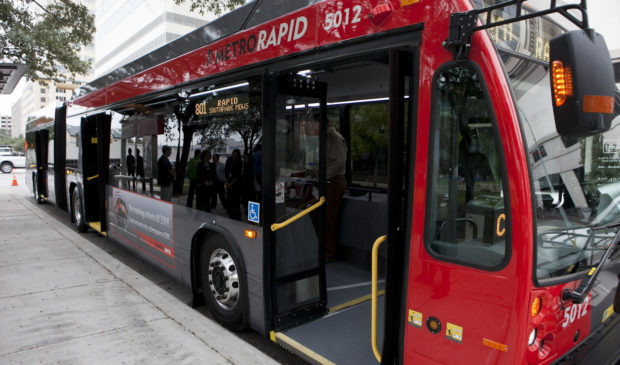Work session reveals new details, wrinkles in Connections 2025 draft
Thursday, December 15, 2016 by
Caleb Pritchard The Capital Metropolitan Transportation Authority could turn toward technology to help pick up riders left stranded by the proposed overhaul of its sprawling transit network.
On Wednesday, planners told the agency’s board of directors that options such as carsharing, vanpooling, flex-route buses or other on-demand services could fill the gaps in coverage created by the frequency-minded Connections 2025 plan.
That reveal came during a special work session that was scheduled last month after riders voiced concern about the draft service plan rewrite’s elimination or alteration of a handful of bus routes, most of them in West Austin.
The members also learned about the potential costs and the possible phasing plan of Connections 2025’s disparate elements.
“This is what makes our network sing,” said Lawrence Deeter, Connections 2025 project manager, while reviewing the 17 high-frequency routes – 13 local buses and four MetroRapids – that would arrive every 15 minutes or less during peak times. Currently, Capital Metro operates two MetroRapid lines and six local bus routes that come and go every quarter-hour or better.
However, the decreased wait times on those routes come at the expense of retreating coverage, which means that planners are proposing certain low-ridership lines be redesigned or thrown out altogether.
Deeter emphasized that 99.4 percent of Capital Metro’s current riders will still live or work within a half-mile of any route along the proposed network, although depending on stop locations, the distance to accessing the transit could be greater for some.
Furthermore, Deeter demonstrated the high cost of maintaining full-service bus routes in the areas that would otherwise lose service under the proposal. For example, operating a full-sized vehicle on Exposition Boulevard to make up for the loss of the Nos. 21 and 22 routes would cost the agency $900,000 each year for an average of 59 extra trips each weekday.
Deeter illustrated similar high costs for relatively low rider returns in areas such as Steck Avenue and Mesa Drive in Northwest Austin and William Cannon Drive west of Brodie Lane in Southwest Austin.
Instead, Deeter and Vice President of Strategic Planning and Development Todd Hemingson proposed deploying alternative service pilot projects in these areas, which they dubbed “Innovation Zones.” The idea would be to operate or contract nimbler options to connect riders in lower-density areas to the larger network of buses that operate at higher efficiencies along denser corridors.
The Connections 2025 plan allows for enough time to test those pilot projects before calling for the realignment that would rob the so-called Innovation Zones of fixed-route transit service.
According to the phasing plan introduced by Deeter, they could be tested through 2019. In the meantime, the new frequent routes would begin debuting in 2018. Infrastructure installation for the two new MetroRapid lines along with increased frequency in MetroRail are set to occur between 2020 and 2022.
Finally, the most ambitious component of Connections 2025 – a bus rapid transit line along Interstate 35 – is not expected to roll out until 2023 at the earliest.
The infrastructure costs of that BRT project alone are estimated to top $134 million, while other capital projects – including new MetroRapid stations, buses and transit-priority treatments – have a projected price tag of nearly $40 million.
“Those numbers are above and beyond our current financial plans,” Deeter told the board. After the meeting, he suggested to the Austin Monitor that the funding mechanisms will likely be determined during the Project Connect planning process, which he explained as the long-term study of the region’s transit options as opposed to Connections 2025’s survey of short-term issues.
During the discussion, City Council Member Delia Garza raised her concerns about the decisions behind some of the proposals in Connections 2025. Specifically, she questioned whether the agency should run the proposed No. 820 MetroRapid bus down East Riverside Drive all the way to Austin-Bergstrom International Airport.
“Why are we extending our Cadillac service when the numbers aren’t there right now?” she inquired rhetorically. “I have never heard from a constituent asking for that.”
Council Member Ann Kitchen grilled the planners about their data and the assumptions they drew from them, as well as the cost figures.
With those questions largely unanswered due to dwindling time, Chairman Wade Cooper suggested that he would schedule at least one more work session before the board will take a final vote on the Connections 2025 draft in January.
The Austin Monitor’s work is made possible by donations from the community. Though our reporting covers donors from time to time, we are careful to keep business and editorial efforts separate while maintaining transparency. A complete list of donors is available here, and our code of ethics is explained here.
You're a community leader
And we’re honored you look to us for serious, in-depth news. You know a strong community needs local and dedicated watchdog reporting. We’re here for you and that won’t change. Now will you take the powerful next step and support our nonprofit news organization?









